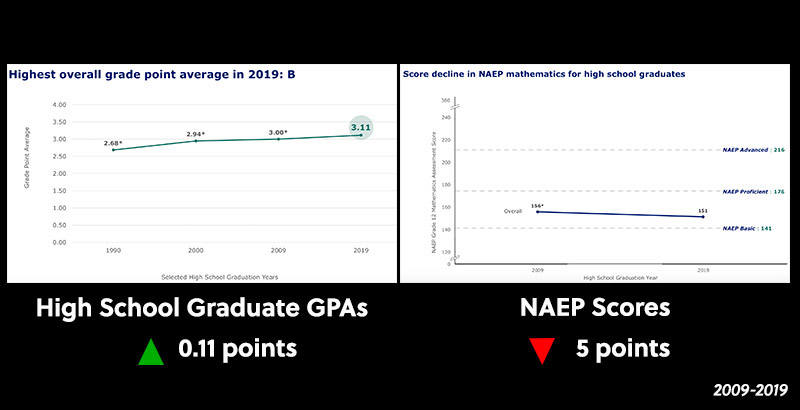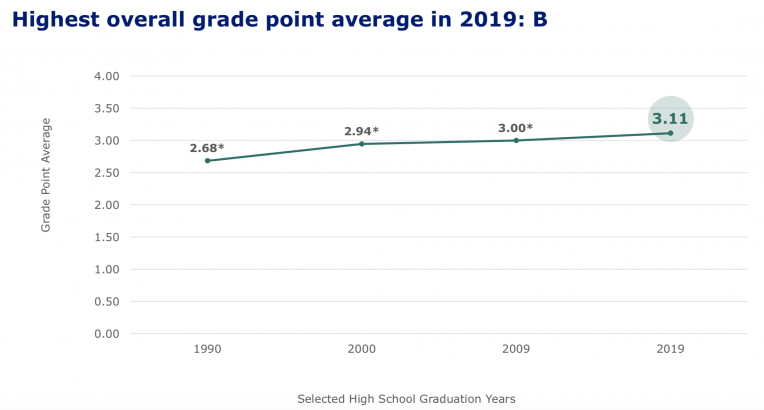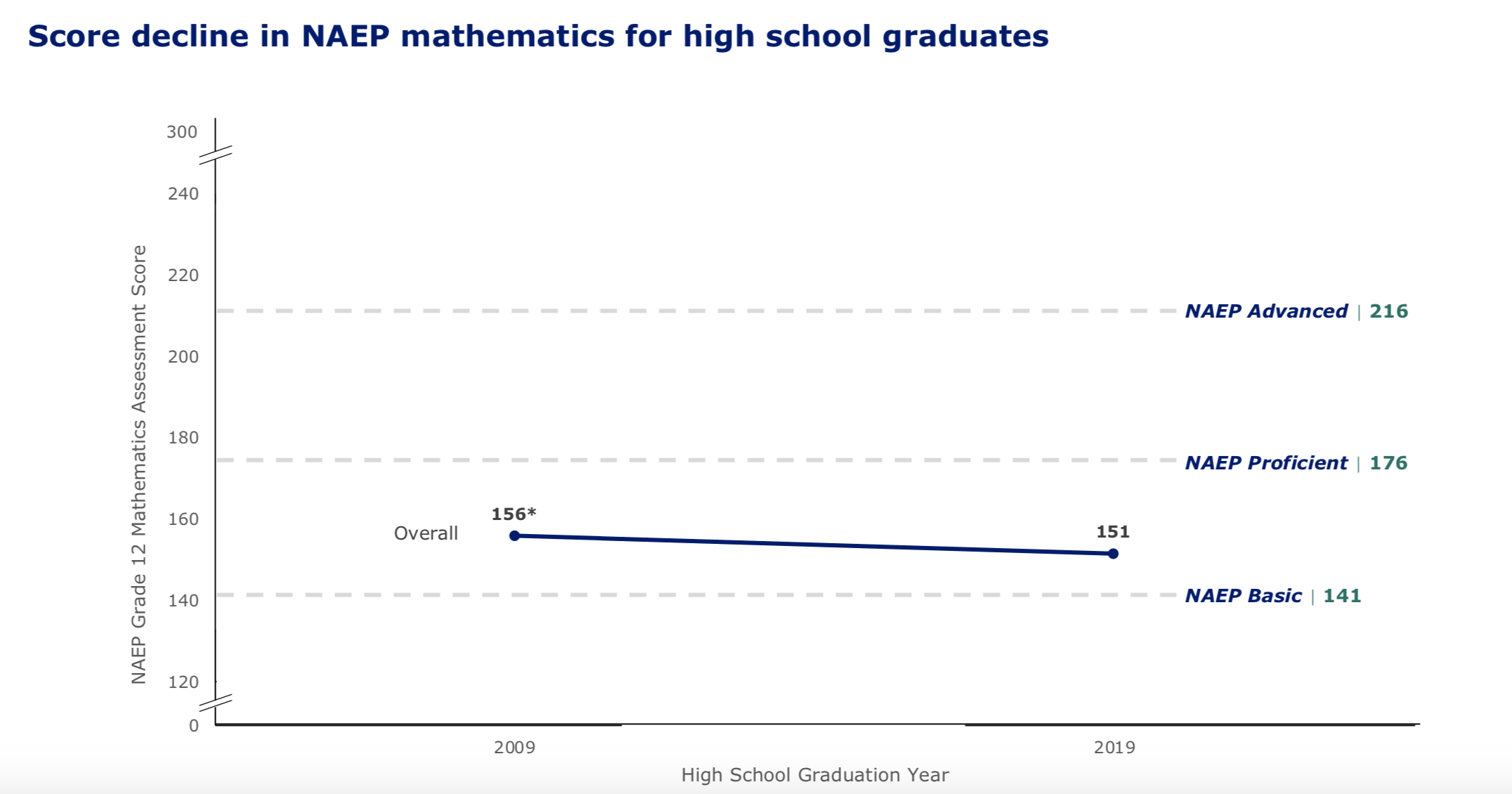Academic Mismatch: Students Earned Record-High GPAs as Scores Lagged on Achievement Tests. Here’s What the New Federal Data Could Mean

Get stories like these delivered straight to your inbox. Sign up for The 74 Newsletter
The grade point averages of high school students hit an all-time high in 2019, and students earned more credits toward graduation than ever before. But those gains are belied by signs that students didn’t demonstrate greater achievement in tests of math and science, according to new national data released Wednesday.
The High School Transcript Study, from the National Assessment of Educational Progress, or NAEP, shows that high school graduates’ overall scores in math declined between 2009 and 2019, while science scores remained flat.
Only students taking the most rigorous math courses — including precalculus or higher — scored at the proficient level. But even their average score declined from 189 to 184 over the 10-year period. During that same decade, the typical high school senior’s graduating GPA rose .11 points to 3.11, or roughly a B average.
Peggy Carr, commissioner of the National Center for Education Statistics, which administers the NAEP program, suggested that the content of high school courses is not always “as advertised.”
“Algebra I is not Algebra I just because it’s labeled Algebra I,” she said during a Tuesday call with reporters, but noted that the reasons behind the mismatch are complex. During a separate interview with The 74, she added, “We do have evidence from prior investigations that these courses may say they’re doing one thing, but they’re suspect about the rigor.”
The good news, she said, is that more students of all backgrounds are taking higher-level courses — often because schools require them for graduation. She also noted that the average scores of Black students taking calculus have increased, from 161 to 177.
The lack of alignment between NAEP results and student performance in high school is not a new phenomenon. Officials reported the same trend in 2009, Carr said.
GPAs have increased for all racial groups over time, but since 1990, the gaps between Black and white students and Hispanic and white students have increased. The study also shows that students are earning their highest GPAs in career and technical courses or in those described as “other” — not in the core academic courses measured by NAEP.

The findings, based on a sample of 14,300 graduates from 1,400 public and private schools, follow a series of NAEP results that point to sagging academic performance for the nation’s students. Data released last fall showed disturbing declines among 13-year-olds in both reading and math between 2012 and 2020. And the gaps between the highest- and lowest-scoring students have grown over time. More students, however, are taking tougher courses in high school. The percentage taking “mid-level” or rigorous courses, including Advanced Placement and International Baccalaureate courses, has climbed since 2000 from 46 percent to 63 percent.
Some say the mismatch between students’ grades and NAEP performance reflects that students earn credit for tasks that don’t necessarily reflect learning. Others argue the traditional A-F grading system is outdated and that grade inflation is rampant: Higher grades might boost students’ confidence and increase graduation rates, some experts say, but leave them less prepared for college.
Seth Gershenson, an associate professor of public policy at American University, who studied the issue in 2018, said the pandemic has probably exacerbated grade inflation, but added he hasn’t seen any recent data on the issue.
“Learning decreased, but a variety of pressures likely kept grades from dipping too hard,” he said. The current NAEP study only reflects scores and GPAs prior to the pandemic.
Carr said her team is already considering what adjustments they’ll have to make when they conduct the next transcript study in 2024, since it will focus on students whose education was disrupted by the pandemic, when many students completed courses online. Most districts across the country shifted to policies that kept grades from slipping below what they were when schools shut down in March, 2020. Some students also had opportunities during the 2020-21 school year to raise their lowest grades.
In Ohio’s Oberlin City Schools, near Cleveland, high school history teacher Kurt Russell said there was some pushback from teachers at his school when administrators decided to give all students an A or a C on the work they submitted once schools shut down.
But even before the pandemic, he said he noticed a shift toward allowing students to make up assignments that were significantly past due.
“In the past, it was a 0 in the gradebook. Now I see a lot of teachers giving full credit for assignments that are very tardy,” said Russell, one of four current finalists for National Teacher of the Year. His policy is to knock off a letter grade for each day an assignment is late.
“I think we still need to hold our students accountable,” he said.
Gershenson also studied teachers’ grading practices in 2020 and found that students learn more when teachers are tougher.
“Teachers who set a higher bar for a good grade had students who went on to learn more, even after they left that teachers’ class,” said Michael Petrilli, president of the conservative Thomas B. Fordham Institute, which published the study. “Students learned to exert more effort. They inferred that their teacher held high expectations for them. Teachers face a ton of pressure to give easy A’s. Those that don’t are real heroes.”

Non-achievement factors
Some experts who study grading policy note that teachers traditionally consider a lot more than a student’s academic work when assigning final grades.
Matthew Townsley, an assistant professor of educational leadership at the University of Northern Iowa, said there’s a “widening disconnect” between GPAs and standardized assessments because course grades reflect a lot of non-achievement factors, such as attendance and assignment completion — regardless of the quality of student performance on assignments.
The NAEP study, he said, could help strengthen the case for a movement called standards-based grading — giving students credit for what they actually learn and often more than one chance to learn it.
Some educators consider the practice more equitable because submitting assignments early or racking up extra credit points might be easier for students with high-speed Wi-Fi at home and access to private tutors, but can be an ongoing struggle for those in lower-income families.
While some schools were moving toward such a grading system before the pandemic, interest has spread as educators look for methods that don’t unfairly disadvantage students in poverty.
“I believe schools seeking to separate achievement from non-achievement factors in their grading were not only well positioned to assess and communicate learning during the pandemic,” Townsley said, “but also to communicate learning in the future that better aligns with NAEP and other external measures.”
Get stories like these delivered straight to your inbox. Sign up for The 74 Newsletter


